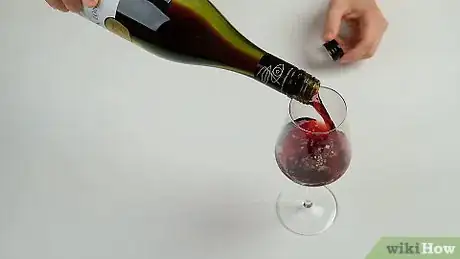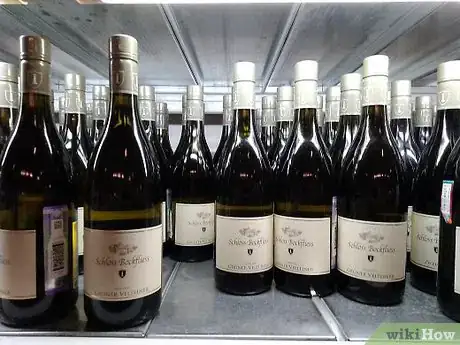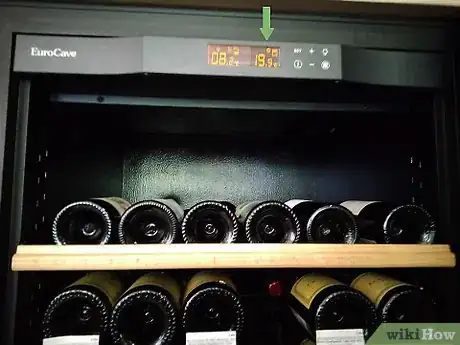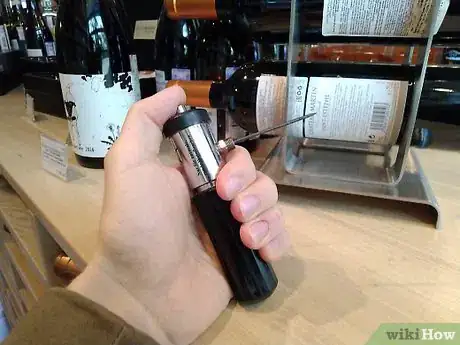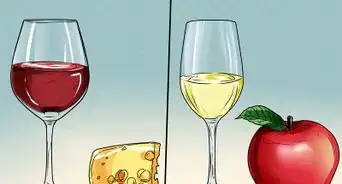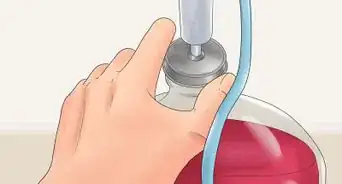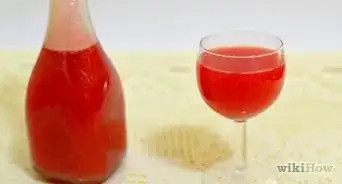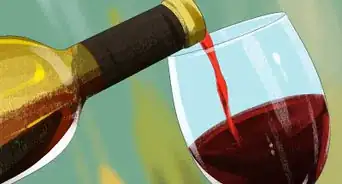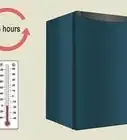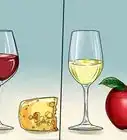This article was co-authored by Murphy Perng. Murphy Perng is a Wine Consultant and the Founder and Host of Matter of Wine, a business that produces educational wine events, including team-building experiences, networking events, and private parties. Based in Los Angeles, California, Murphy has served as a Wine Educator for clients such as Google, Buzzfeed, Tiktok, Snapchat, and Equinox and been featured on National Geographic and The Somm Journal. Murphy possesses her WSET (Wine & Spirit Education Trust) Level 3 Advanced Certification.
There are 16 references cited in this article, which can be found at the bottom of the page.
wikiHow marks an article as reader-approved once it receives enough positive feedback. In this case, several readers have written to tell us that this article was helpful to them, earning it our reader-approved status.
This article has been viewed 1,739,398 times.
If you've begun your own wine collection, you may have run into an issue facing wine connoisseurs for centuries: how to store it properly. Keep in mind that most wines you get in the store are meant to be drunk within a few years. If you're like most people, you drink these wines within a few weeks, so storing them isn't a big deal. For wines you want to keep longer, you do have to take a bit more care. Also, storing wine once you've opened a bottle can be a conundrum, but you can take steps to keep it drinkable for a few days.
Steps
Storing Table Wines
-
1Drink inexpensive light wines within a few weeks. At wineries, some wines will be labeled "table wines," meaning they're meant to be drunk instead of kept for years. Lighter wines, including both red and white, fall into this category. Another indicator is the cork. If it's synthetic or a screw top, the wine is probably meant to be drunk fairly quickly.[1]
- Most wines you'll see in the stores are meant to be consumed fairly quickly, usually within 5 years.[2]
-
2Put white wines in the refrigerator. White table wines are meant to be chilled, and they will be just fine in the refrigerator. For these wines, you should buy them and drink them within a month or 2.[3]Advertisement
-
3Keep red wines in a cool wine rack. If you plan to drink these wines within a month, you can even store them on the counter as long as they are out of direct sunlight. If your counter does get direct sunlight, opt for a below-the-counter rack to hide the wine away.[4]
- If your house often gets above 77 °F (25 °C), this isn't a good option for you. Pick a cooler spot in the house or even keep them in the refrigerator if you need to.
Keeping Wines for Longer Periods
-
1Get advice on which wines can be aged. Most wineries can tell you which wines are meant to age and which ones are not. Similarly, in a wine store, a sommelier can help you determine which wines are meant for aging. Typically, though, these wines will have natural corks, and they will often set you back quite a bit more than your average wine.[5]
- You can also buy wine at auctions or purchase wine "futures" from wineries, meaning you buy it before it comes out at a discounted price.
- Common regions that produce higher end wines for aging include Tuscany (Italy), Piedmont (Italy), Napa Valley (California), Priorat (Spain), Rioja (Spain), Burgundy (France), and Bordeaux (France).
-
2Pick a dark area away from your AC and washing machine. A cool, dark closet is ideal for most people if you don't have access to a wine cellar. Wine needs to be kept out of the light, particularly sunlight, which can degrade it over time. Choose an area away from vibrating machinery because these vibrations can also degrade your wine.[6]
- If you can't keep a bottle entirely out of the light, wrap it lightly in a cloth or simply put the bottle inside a box out of the way.
-
3Place the bottles on their sides. Natural cork can dry out over the years, leading to oxidation of your wine. Storing bottles on their sides will help with this issue, as the wine will keep the corks moist.[7]
- This is mainly important if you plan on storing wine for 10 years or so. However, storing wine on its side is also a good way to save space.[8] It will also cause the cork to expand, which will prevent air from getting into the wine.[9]
- When placing the bottles, try to store them so you don't have to move one to get to another. You want to leave the bottles alone as much as possible.
-
4Use a thermometer to maintain a constant temperature of 55 °F (13 °C). If you have a below-ground cellar, that's typically ideal, but you should check the temperature throughout the summer to make sure it's staying cool enough. However, consistency in temperature is even more important. If you can keep it in area that only fluctuates between 68 to 73 °F (20 to 23 °C) instead of 45 to 65 °F (7 to 18 °C), that's better, as fluctuations can push wine out of the cork or draw air in.[10]
- Avoid letting wine stay in temperatures over 75 °F (24 °C), except for very short periods. Wine starts to oxidize at this temperature.[11]
- Also, don't let the wine drop below 45 °F (7 °C), as that slows down the aging process. Plus, if it begins to freeze, the expanding wine could pop the cork out, ruining your wine.
- If you can't find a space that's cool enough, try a cooling unit that's made for wine.
-
5Use a humidifier to hit 50-70% humidity in particularly dry areas. In most areas, a humidifier won't be necessary. However, you should check how dry your storage area is with a hygrometer (humidity reader) and make sure it stays within this range.[12]
- This is most important if you're storing wines for longer than 10 years. Over time, the cork can dry out if the humidity is too low. You can add a pan of water or even a cool humidifier if the room is not humid enough.
- Humidity over 80% may encourage mold growth. You can use a dehumidifier if you need to decrease the humidity.
-
6Try an under-the-counter wine refrigerator for an easy option. If you plan to keep certain bottles for a long time, this is likely your best bet. These refrigerators will keep the wine at a constant temperature and humidity, helping preserve it for the long haul.[13]
- Since they fit under a counter, they don't take up too much space and will keep your wine in the dark.
-
7Store very expensive wines in professional wine lockers. If you've bought wine that you worry about keeping for years, you may just want to have it kept in a wine locker at a local wine store or winery. They will ensure your wines are always at the perfect temperature and humidity.[14]
- This works best if you plan to keep your wines more than 15 years.
Storing Wine after Opening
-
1Place the cork back in and put the wine in the refrigerator for an easy short-term solution. This is the simplest way to store leftover wine, but it will go bad within a day or so. Always put the stained side of the cork back in the bottle, as it's already added any flavors to the wine it's going to.[15] If your wine has a screw top, you can use that as well.[16]
- You can also use a simple wine stopper, which you can get at most stores.
- The wine will keep for 3-5 days, but the flavor will be affected after a day.
-
2Pour leftover wine into a half bottle to reduce air exposure for a bit longer storage. Air is what causes wine to spoil, so if you can reduce the amount of air the wine is exposed to, it will keep a bit longer. Funnel it into a half bottle and cap it off with the cork or a wine stopper. Pour the wine into the half bottle right when you open the big bottle, as that will reduce the amount of time it's exposed to air.[17]
- Don't forget to stick it in the refrigerator.
- This method might prolong the flavor for an extra day, meaning you'll get 2 days instead of 1 for optimum flavor.
-
3Use a needle opener to keep from exposing wine to air in the first place. These openers use a needle to withdraw wine from the bottle through the cork. It pumps argon gas into the bottle to make up for the wine it takes out. When you pull the needle out, the cork re-seals the hole.[18]
- This will keep wine fresh much longer, but you should still drink it within a few weeks to a month. With this device, it's not as important to put leftover wine in the refrigerator.
-
4Try other preservation gadgets, such as vacuum seals and inflatable corks. These devices help limit the wine's exposure to air, and they may keep the wine drinkable for up to 3-5 days. To use a vacuum sealer, simply place the gadget in the top of the bottle and use the hand pump to create the seal.[19]
- Similarly, with a hand cork, place it in the bottle and use the provided hand pump to blow it up and create a seal.
- Place the wine in the refrigerator.
Community Q&A
-
QuestionShould a wine rack slant backward or forward?
 Community AnswerIt depends on the wine and how it's sealed. Real cork bottles should be stored slanting forward so the wine can keep the cork moist. Storage direction doesn't matter much with screw top bottles though.
Community AnswerIt depends on the wine and how it's sealed. Real cork bottles should be stored slanting forward so the wine can keep the cork moist. Storage direction doesn't matter much with screw top bottles though. -
QuestionCan I put an open bottle of wine in the freezer?
 Community AnswerNo, that would ruin it. You can store an open bottle of red wine in the fridge for about 3 days, or 2 days if it's white wine.
Community AnswerNo, that would ruin it. You can store an open bottle of red wine in the fridge for about 3 days, or 2 days if it's white wine. -
QuestionHow long can you store wine?
 Community AnswerMost wines will keep unopened for many years.
Community AnswerMost wines will keep unopened for many years.
Warnings
- Don't store wine with foods that ferment or mold, such as cheese or fruit and vegetables. Moldy flavors can enter stored wine through the cork.⧼thumbs_response⧽
References
- ↑ https://www.eater.com/drinks/2015/3/12/8152007/ask-a-somm-how-do-i-know-which-bottles-of-wine-to-age
- ↑ https://www.businessinsider.com/how-to-store-wine-for-a-long-time-2015-8
- ↑ https://www.eater.com/drinks/2016/5/13/11664744/best-store-wine-temperature-cool-dark-cork
- ↑ https://www.eater.com/drinks/2016/5/13/11664744/best-store-wine-temperature-cool-dark-cork
- ↑ https://www.businessinsider.com/how-to-store-wine-for-a-long-time-2015-8
- ↑ https://www.eater.com/drinks/2016/5/13/11664744/best-store-wine-temperature-cool-dark-cork
- ↑ https://www.tasteofhome.com/article/storing-wine-at-home/
- ↑ https://www.winespectator.com/articles/how-to-store-wine-temperature-humidity-coolers-and-more
- ↑ Murphy Perng. Wine Specialist. Expert Interview. 15 March 2019.
- ↑ https://www.winespectator.com/articles/how-to-store-wine-temperature-humidity-coolers-and-more
- ↑ http://www.cellarnotes.net/storing_wine.html
- ↑ https://www.winespectator.com/articles/how-to-store-wine-temperature-humidity-coolers-and-more
- ↑ https://www.eater.com/drinks/2016/5/13/11664744/best-store-wine-temperature-cool-dark-cork
- ↑ https://www.businessinsider.com/how-to-store-wine-for-a-long-time-2015-8
- ↑ https://www.winemag.com/2015/05/15/5-tips-for-storing-opened-wine/
- ↑ https://www.today.com/food/what-s-best-way-save-leftover-wine-you-ll-never-t75541
- ↑ https://www.winemag.com/2015/05/15/5-tips-for-storing-opened-wine/
- ↑ https://www.winemag.com/2015/05/15/5-tips-for-storing-opened-wine/
- ↑ https://www.today.com/food/what-s-best-way-save-leftover-wine-you-ll-never-t75541
About This Article
To store wine after it has been opened, cork the bottle tightly. Transfer the wine to a smaller bottle if there is only a little left to minimize the amount of air that comes into contact with the wine. If you’re storing white wine, place the corked bottle in a wine cellar or in the refrigerator, where it will stay good for 3-5 days. If you’re storing red wine, you can leave it at room temperature in a dark place, where it will also stay good for 3-5 days. For a dessert wine such as sherry or port, keep it at room temperature, for a week or more. To learn how to store wine before it's opened, keep reading the article!
